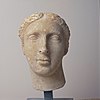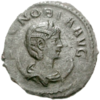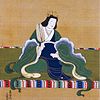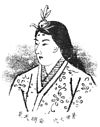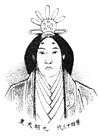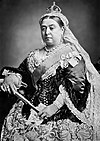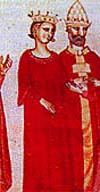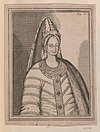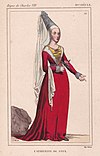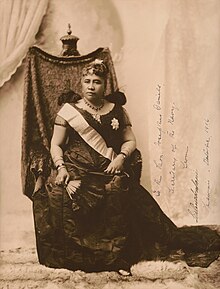Female monarchs in their own right
Top left: Elizabeth II is the longest-reigning female monarch, ruling as Queen of the United Kingdom for 70 years, from 1952 to 2022. Top right: Queen Victoria ruled the United Kingdom for 63 years, from 1837 to 1901; the longest at the time. Bottom left: Wilhelmina , Queen of the Netherlands for 58 years from 1890 to 1948, is the longest-reigning female monarch outside the United Kingdom. Bottom right: Margrethe II was Queen of Denmark for 52 years, from 1972 until her abdication in 2024; she is the most recent female monarch of a sovereign state. This is a list of current and former female monarchs regardless of title, including queens regnant , empresses regnant, pharaohs and monarchs by other titles (grand duchess, princess, etc.). Consorts, such queens consort (i.e. spouses of male monarchs) are not included, see list of current consorts of sovereigns . Female regents are not included, see list of regents .
The following is an incomplete list of women monarchs who are well known from popular writings, although many ancient and poorly documented ruling monarchs (such as those from Africa and Oceania ) are omitted. Section 1 lists monarchs who ruled in their own right, such as queens regnant . Section 2 lists legendary monarchs. Section 3 lists constituent monarchs: monarchs who ruled in their own right, but had no constitutional standing or regal powers while in power. Section 4 lists various female rulers who were referred to with the title "Chieftainess." Regents, such as queens regent, are not monarchs and are not included in this page. Pretenders to thrones are also not included in this page.
The Canary Islands are Spanish territories of North Africa.
Peraza family
Monarch
Portrait
Title
Reign dates
Length
Ref.
Inés Peraza
–
Queen
1452–1477
25 years
[ 1]
Kingdom of the Canary Islands list of titles and honours of the Spanish Crown .
The first verified female monarch of Egypt is Sobekneferu of the Twelfth dynasty . However, queens from earlier periods such as Neithhotep , Merneith and Khentkaus I held powerful positions and may have ruled Egypt in their own right, but the archaeological evidence is ambiguous.[ 2]
Monarch
Portrait
State
Reign dates
Length
Ref.
Hude
–
Hogbonu
1746–1752
6 years
[ 23]
Akan state of Denkyira
Akan state of Dwaben
Akan state of Akyem Abuakwa
Gã
Orango
Roxa
Baoule
Pokou (reigned c. 1750 – c. 1760 )[ 27] Akwa Boni (reigned c. 1760 – c. 1790 )[ 27] Mali Empire
Daura
The title "Kabara" was used by female monarchs who ruled over the Hausa people in the Middle Ages. A line of matriarchal monarchs is recorded in the Kano Chronicle Daurama in the 9th century.[ 29] c. 700 to c. 1000 .[ 30]
Kufuru
Ginu
Yakumo
Yakunya
Wanzamu
Yanbamu
Gizir-gizir
Inna-Gari
Daurama
Ga-Wata
Shata
Fatatuma
Sai-Da-Mata
Ja-Mata
Ha-Mata
Zama
Sha-Wata
Daurama IIIgodomigodo
Ondo Kingdom
Zazzau
Amina – There is controversy among scholars as to the date of her reign, one school placing her in the mid-15th century, and a second placing her reign in the mid to late 16th century.Ifẹ
Oyo Empire
Igala Kingdom
Akure Kingdom
Èyé Àró (reigned 1393–1419)
Èyémọ̀ị́n (reigned 1705–1735)
Amọ́robíòjò (reigned 1850–1851) Lingeer 's leadership activities were carried out at the highest tier, as a co-monarch.
Koya Temne
Fatima (reigned 1826–1840)[ 32] Kpa Mende
Mbunda Kingdom
Kingdom of kongo Kongo Civil War .
Kanem–Bornu Empire
Bambao
Itsandra
Bajini
Monarch
Portrait
Title
State
Start of reign
End of reign
Length
Zewditu
Empress
Ethiopian Empire
27 September 1916
2 April 1930
Ambohidratrimo
Menabe
Bemihisatra
Bemazava
Antankarana
Angoche Sultanate
Queen of Angoche, name unknown (reigned in the 16th century) – she succeeded her brother and was succeeded by her husband Molidi[ 40] Sultanate of Ifat
Shilluk Kingdom
Abudok [fr ] , the eighth ruler (and only queen) of the Shilluk.[ 42] Unguja
Pemba Island
Tumbatu Island
Kua
Mikindani
Elizabeth II (reigned 1952–1961) AmaMpondomise
Lobedu people
The Modjadji or Rain Queen is the hereditary queen of Lobedu , the people of the Limpopo Province of South Africa . The succession to the position of Rain Queen is matrilineal , meaning that the Queen's eldest daughter is the heir, and that males are not entitled to inherit the throne at all. The Rain Queen is believed to have special powers, including the ability to control the clouds and rainfall .
Victoria (reigned 1837–1901)Elizabeth II (reigned 1952–2022) Coba
Ecatepec
Palenque
Sak Kʼukʼ Tepetlaoztoc
Azcasuch (reigned in the late 15th–early 16th century)Toltec Empire
Toniná
Tzacoalco
Mixtec
Elizabeth II (reigned 1981–2022) Pusilha
El Perú
La Florida
Naranjo
Tikal
Monarch
Portrait
Title
State
Start of reign
End of reign
Length
Ref.
Elizabeth II
Queen
Antigua and Barbuda
1 November 1981
8 September 2022
Queen
Bahamas
10 July 1973
8 September 2022
Queen
Barbados
30 November 1966
30 November 2021
Queen
Grenada
7 February 1974
8 September 2022
Queen
Jamaica
6 August 1962
8 September 2022
Queen
Saint Kitts and Nevis
19 September 1983
8 September 2022
Queen
Saint Lucia
22 February 1979
8 September 2022
Queen
Saint Vincent and the Grenadines
27 October 1979
8 September 2022
Queen
Trinidad and Tobago
31 August 1962
1 August 1976
Maria I (reigned as Queen of Brazil 1815–1816) – she was also Queen of Portugal in 1777–1816Eastern Kingdom of Women [zh ] Tibet , there was Nüguo (Chinese : 女國 , lit. "Kingdom of Women"), also known as Dong nüguo (Chinese : 東女國 , lit. "Eastern Kingdom of Women"), related to the tribe Sumpa .[ 58]
Wuman
Monarch
Title
State
Start of reign
End of reign
Length
Kalindi
Rani
Chakma Circle
1832
1873
41 years
Elizabeth II (reigned 1952–1956) Assacani
Gilgit
Kanhaiya Misl
Soomra dynasty
Hamoon (reigned 1107) – she occupied the throne after her husband Sanghar's death, but was soon crushed by the nobles[ 83] Hanthawaddy
Sandoway
Waithali
Laihka State
Kingdom of Tondo
Kingdom of Maynila
Queen of Maynila, name unknown (reigned c. 1521 ) – she succeeded her husband Salalila and was succeeded by her son Matanda ; according to oral traditions, her name is "Ysmeria" Sultanate of Sulu
Hariphunchai
Pattani
Lanna
There were many chiefdoms on Timor , but according to the hierarchy among the Timorese domains, the ruler of Sonbai of West Timor, the ruler of Wehali of Central Timor, and the ruler of Likusaen (today: Liquiçá ) of East Timor were three paramount rulers of Timor.[ 101]
Liquiçá
Israel and Palestine [ edit ] Gileadite
Nabatea
Tripoli County of Tripoli was an autonomous state.[ 104]
Bāzu
Iapa, queen of the city Dihrani – Esarhaddon conquered eight kings and queens of the land Bāzu[ 105]
Baslu, queen of the city Ihilum – Esarhaddon conquered eight kings and queens of the land Bāzu[ 105] Qedarite
Zabibe (reigned c. 750 –735 BC)Samsi (reigned c. 735 –710 BC)Yatie (reigned c. 710 –695 BC)Te'el-hunu (reigned c. 695 –690 BC)Tabua (reigned c. 678 –675 BC)Tanukhids
Mavia (reigned 375–425) – "The Queen of the Arabs"Seleucid Empire
Palmyrene Empire
Zenobia (reigned 272) – she ruled mostly as regent for her son but reigned briefly under the regnal name Septimia Zenobia Augusta in 272.Antioch Principality of Antioch was an autonomous state.[ 104]
Armenian Kingdom of Cilicia
Isabella of Armenia Caria
Dardania
Heraclea Pontica
Pontus
Olba Kingdom
Prusias ad Mare
Saltukid dynasty
Trebizond
Sulayhid dynasty
Asma bint Shihab (reigned 1047–1087) – she was the co-ruler of Yemen in co-regency with her cousin and spouse, Ali al-Sulayhi , and later her son, Ahmad al-Mukkaram, and daughter-in-law, Arwa al-Sulayhi. Though there were many female monarchs in the Muslim world, Asma bint Shihab and Arwa al-Sulayhi were the only female monarchs in the Arab world to have had the khutba Arwa al-Sulayhi (reigned 1067–1138) – she ruled Yemen firstly with her first two husbands and her mother-in-law and then as sole ruler. She was the greatest of the rulers of the Sulayhid Dynasty and was also the first woman to be accorded the prestigious title of hujja in Isma'ili branch of Shi'a Islam , signifying her as the closest living image of God's will in her lifetime.Queen of Greater Yuezhi , name unknown (reigned in the 2nd century BC) – after the king of the Greater Yuezhi was killed by the Xiongnu , his wife became the new monarch of Greater Yuezhi[ 106] [ 107] [ edit ] Marcomanni
Poland and Lithuania [ edit ]
Monarch
Portrait
Title
State
Start of reign
End of reign
Length
Ref.
Erato
Queen
Kingdom of Armenia
8 BC
5 BC
3 years
2 BC
2 AD
4 years
6 AD
12 AD
6 years
Kingdom of Hereti
Sabir people
Kingdom of the Cimmerian Bosporus
Blue Horde
Khanate of Qasim
[ edit ] Agder
Luxembourg and Belgium [ edit ] Burgundian Netherlands
Spanish Netherlands
Austrian Netherlands
Grand Duchy of Luxembourg
United Kingdom and Ireland [ edit ]
Monarch
Portrait
Title
State
Start of reign
End of reign
Length
Ref.
Cartimandua
Queen
Brigantes
c. 43
c. 69
c. 25 years
Boudica
Queen
Iceni
c. 60
c. 61
c. 1 year
Seaxburh
–
Queen
Wessex
c. 672
c. 674
c. 2 years
Æthelflæd
Lady
Mercia
911
918
c. 7 years
Ælfwynn
–
Lady
Mercia
12 June 918
4 December 918
Matilda
Lady (disputed )
England
8 April 1141
1148
c. 7 years
[ 111]
Margaret
Queen (disputed )
Scotland
19 March 1286
September 1290
4 years, 6 months
Mary, Queen of Scots
Queen
Scotland
14 December 1542
24 July 1567
Jane
Queen (disputed )
England
10 July 1553
19 July 1553
[ 112]
Ireland
Mary I of England
Queen
England
24 July 1553
17 November 1558
Ireland
Elizabeth I
Queen
England
17 November 1558
24 March 1603
Ireland
Mary II
Queen
England
13 February 1689
28 December 1694
Ireland
Scotland
11 April 1689
Anne
Queen
England
8 March 1702
1 May 1707
Scotland
Ireland
1 August 1714
Great Britain
1 May 1707
Victoria
Queen
United Kingdom
20 June 1837
22 January 1901
Elizabeth II
Queen
United Kingdom
6 February 1952
8 September 2022
Odrysian kingdom
Zoe Aeacid dynasty
Byzantine Empire
Irene of Athens (reigned 797–802) – she normally referred to herself as basilissa (empress), although there are three instances of the title basileus (emperor) being used by her. From 792 she was a co-ruler.Theodora the Armenian (reigned 842–856, disputed) - after the death of her husband she became the co-ruler of her son but in fact she ruled the empire alone; some historians regard her as an empress regnant rather than just a regentThekla (reigned 842–856, disputed), co-ruler of Theodora the Armenian Zoë Porphyrogenita (reigned 1028–1041 and 1042–1050) – she ruled with her consorts Romanos III and Michael IV between 1028 and 1041; she ruled with her sister Theodora and her third husband Constantine IX from 1042 to 1050Theodora Porphyrogenita (reigned 1042–1056) – she ruled from 1042 jointly with her sister Zoe and Zoe's third husband Constantine IX; she ruled from 1055 until her own death as sole monarch.Eudokia Makrembolitissa (reigned 1067, disputed) - after the death of her husband she became a ruler; some historians regard her as an empress regnant rather than just a regentEpirus
Frankokratia Latin Empire was disestablished in 1261, but Latin states in Greece , also known as Frankokratia , continued to recognize Latin emperors in exile as their overlords until 1383.
Polis
Ostrogothic Kingdom
Amalasuintha (reigned 534–535) – she ruled first as regent for her son and thereafter as queen regnant in her own rightSardinian medieval kingdoms
Kingdom of Sicily
Kingdom of Naples
Italian states from the Congress of Vienna to the unification of Italy [it ] Congress of Vienna became fully sovereign because the Kingdom of Italy was not restored.
Monarch
Portrait
Title
State
Start of reign
End of reign
Length
Ref.
Jimena Díaz
Princess
Principality of Valencia
1099
1102
Urraca the Reckless
Empress
Hispania
30 June 1109
8 March 1126
Queen
León
Queen
Castile
Queen
Galicia
1111
Petronilla
Queen
Aragon
13 November 1137
18 July 1164
Urraca the Asturian
–
Queen
Kingdom of Artajona [eu ]
1144
1153
Berengaria
Queen
Castile
6 June 1217
31 August 1217
Queen
Toledo
Sancha
–
Queen
León
24 September 1230
11 December 1230
Dulce
–
Queen
León
24 September 1230
11 December 1230
Joan I
Queen
Navarre
22 July 1284
2 April 1305
Joan II
Queen
Navarre
1 April 1328
6 October 1349
Isabella of Foix-Castelbon
–
Co-Princess
Andorra
1398
1412
Blanche I
Queen
Navarre
8 September 1425
1 April 1441
Blanche II
–
Queen
Navarre
23 September 1461
2 December 1464
Isabella I
Queen
Castile
11 December 1474
26 November 1504
Queen
León
Eleanor
–
Queen
Navarre
28 January 1479
12 February 1479
Catherine
Queen
Navarre
7 January 1483
12 February 1517
Co-Princess
Andorra
Joanna the Mad
Queen
Castile
26 November 1504
12 April 1555
Queen
Aragon
23 January 1516
Queen
Upper Navarre
Jeanne d'Albret
Queen
Lower Navarre
25 May 1555
9 June 1572
Co-Princess
Andorra
Isabella II
Queen
Spain
29 September 1833
30 September 1868
Queen
Upper Navarre
30 November 1833
Monarch
Portrait
Title
State
Start of reign
End of reign
Length
Ref.
Elizabeth II
Queen
Malta
21 September 1964
13 December 1974
Duklja
Victoria (reigned 1901)Elizabeth II (reigned 1952–2022) Elizabeth II (reigned 1952–2022) Rarotonga
Makea Takau Ariki [ edit ]
Monarch
Portrait
Title
State
Start of reign
End of reign
Length
Ref.
Elizabeth II
Tui Viti
Fiji
1970
1987
Queen
Papua New Guinea
1975
2022
Queen
Solomon Islands
1978
2022
Tui Manuʻa Matelita. Bora Bora
Huahine
Tehaapapa II and Tehaapapa III Raiatea
Rapa Iti
Rimatara
Tahiti
Purea (reigned in the 18th century), queen of the Teva clan on the southern part of the island before unificationPōmare IV (reigned 1827–1877)Nuku Hiva
Vaekehu – her husband died in 1863, but Vaekehu continued to reign on her own as QueenAncient Hawaii
Kalanikauleleiaiwi (reigned 1695–1725) — co-ruler of Hawaiʻi Island along with her brother Keaweʻīkekahialiʻiokamoku Ululani , Chiefess of Hilo Kapau-a-Nuʻakea , 3rd Chiefess of Molokai Kamauliwahine , 4th Chiefess of Molokai Hualani , 5th Chiefess of MolokaiKanealai , Chiefess of Molokai Kūkaniloko , 11th Moʻi of Oʻahu Kalaimanuia , 12th Moʻi of Oʻahu (reigned 1600–1665)Kaikilani , 17th Moʻi of Hawaiʻi Island (reigned 1575–1605)Keakamahana , 19th Moʻi of Hawaiʻi Island (reigned 1635–1665)Keakealaniwahine , 20th Moʻi of Hawaiʻi Island (reigned 1665–1695)Kamakahelei , 22nd Moʻi of Kauaʻi (reigned 1770–1794)Kingdom of Hawaii
Liliʻuokalani Elizabeth II (reigned 1978–2022) Uvea
Legendary and mythological monarchs [ edit ] Women written in italics in the list of Kuba Kingdom rulers:[ 117]
Lobamba
Gokare
Sanga Motunu
Pelama Pena
Boeke
Sanga Lenga
Bosh Akama
Kele Kama
Bolueme Nitocris of the Sixth Dynasty – Nitocris is mentioned within Herodotus ' book Histories Charoba – A queen mentioned in a history of Egypt written by 12th-century Arab writer Murtada ibn al-'Afif .[ 118]
Daluka of the Soleyman Dynasty – An Antediluvian monarch from medieval Coptic and Arabic texts who supposedly built a wall around Egypt to protect the country from invasion and also was said to have built a pyramid and a nilometer at Memphis . Sometimes claimed to be a cousin of Charoba and her immediate successor.[ 118] Borsa of the Soleyman Dynasty – Mentioned in medieval Coptic and Arabic texts as a ruler of Egypt in the Antediluvian era.[ 119] [ 118] The following names all come from a regnal list written in 1922, which is partially based on native traditions and older regnal lists, but also contains additional names of Coptic and Nubian origin, the latter due to its association with the word "Aethiopia Ethiopian calendar .[ 120]
Borsa (reigned 4321–4254 BC) – Originated from Coptic tradition.[ 119]
Eylouka (reigned 3776–3731 BC) – Originated from Coptic tradition.[ 119] Nehasset Nais (reigned 2434–2404 BC)
Kasiyope (reigned 1890–1871 BC) – Originated from Greek mythology .Mumazes reigned (1675–1671 BC) – Daughter of king Bonu I.[ 121]
Aruas (reigned 1671 BC) – Daughter of Mumazes.[ 120]
Helena (reigned 1358–1347 BC)
Makeda (reigned 1013–982 BC) – The Biblical queen of Sheba in Ethiopian tradition and mother of Menelik I . She succeeded to the throne after the death of her father king Kawnasya.[ 122] Nicauta Kandake I (reigned 740–730 BC)
Hadina (reigned 372–362 BC) – Most regnal lists of Ethiopia claim this monarch reigned for 9 years.[ 123]
Nikawla Kandake II (reigned 342–332 BC) – An alternate name for the Queen of Sheba [ 124]
Akawsis Kandake III (reigned 325–315 BC)
Nikosis Kandake IV (reigned 242–232 BC)
Awsena (reigned 99–88 BC) – Most regnal lists of Ethiopia claim this monarch reigned for 1 year.[ 123]
Nicotnis Kandake V (reigned 35–25 BC)
Garsemot Kandake VI (reigned 40–50 AD) – Supposedly the Kandake Ethiopian Eunuch .[ 120]
Wakana (reigned 230 AD) – Reigned for 2 days.[ 120]
Ahywa Sofya (reigned 299–332 AD) – Likely based on Sofya of Axum , mother of Ezana .
Adhana I (reigned 369–374 AD) – Some regnal lists of Ethiopia claim this monarch reigned for 14 years.[ 125]
Adhana II (reigned 412–418 AD) – Some regnal lists claim this monarch co-ruled with king Abreha III.[ 125] Gudit (reigned c. 960 – c. 1000 )Lady Saso , honorary queen regnant of Silla Queen of Jeoknyeo-guk – Talhae 's mother was the princess of Jeoknyeo-guk (Korean : 적녀국 Hanja : 積女國 [ 129] Dido (reigned 814–c. 760 BC ) – also known as Alyssa . Founder of Carthage , according to traditionConstituent and self-proclaimed monarchs [ edit ] Trinidad and Tobago [ edit ] The list of Carib Queens were:
United States Virgin Islands [ edit ] The leaders of the 1878 St. Croix labor riot were:
United States of America [ edit ] Semi-independent feudal rulers [ edit ] Swedish Estonia
Russian Estonia
Catherine I (reigned 8 February 1725 – 17 May 1727)Anna (reigned 13 February 1730 – 28 October 1740)Elizabeth (reigned 6 December 1741 – 5 January 1762)Catherine II (reigned 9 July 1762 – 6 November 1796)Swedish Finland
Norwegian Iceland
Israel and Palestine [ edit ] Thutmose III of the New Kingdom of Egypt conquered Canaan .
Thutmose I of the New Kingdom of Egypt conquered Nubia .
^ "El linaje español más antiguo en Canarias :: Revista de historia" . mdc.ulpgc.es . Archived from the original on 2022-09-27.^ Tyldesley, Joyce. Chronicle of the Queens of Egypt . pp. 26–29, 33–34, 52–53. ^ Shaw, Ian, ed. (2003). The Oxford History of Ancient Egypt ISBN 978-0-19-815034-3 ^ Bennett, Chris. "Arsinoe II" . Egyptian Royal Genealogy . ^ Stanwick, Paul Edmund (22 July 2010). Portraits of the Ptolemies: Greek Kings as Egyptian Pharaohs ISBN 9780292787476 ^ Chrystal, Paul (2017-02-28). Women at War in the Classical World ISBN 978-1-4738-5661-5 Arsinoe III was Queen of Egypt from 220–204 BCE, ^ Chris Bennett. "Cleopatra I" . Tyndale House. Retrieved December 21, 2023 . ^ Cleopatra II Archived 23 May 2011 at the Wayback Machine by Chris Bennett^ Cleopatra III Archived 5 October 2011 at the Wayback Machine by Chris Bennett^ Cleopatra IV Archived 24 September 2011 at the Wayback Machine by Chris Bennett^ Berenice III Archived 5 October 2011 at the Wayback Machine by Chris Bennett^ Cleopatra V Archived 26 November 2011 at the Wayback Machine by Chris Bennett^ Tyldesley, Joyce (2006), Chronicle of the Queens of Egypt 200 , ISBN 0-500-05145-3 ^ Tyldesley, Joyce (2019). The Pharaohs . London: Quercus. p. 209. ISBN 978-1-78747-900-5 ^ Burstein, Stanley M. (2004). The Reign of Cleopatra ISBN 978-0-313-32527-4 ^ Arsinoe IV Archived 26 November 2011 at the Wayback Machine by Chris Bennett^ Bryce, Trevor (2014). Ancient Syria: A Three Thousand Year History . Oxford University Press. p. 304. ISBN 978-0-19-100292-2 ^ Droa-Krupe, Kerstin; Fink, Sebastian (2021). Powerful Women in the Ancient World: Perception and (Self)Presentation ISBN 978-3-96327-139-7 ^ Kuckertz, Josefine (2021). "Meroe and Egypt" . UCLA Encyclopedia of Egyptology : 5. ^ a b Török, László (2015). The Kingdom of Kush: Handbook of the Napatan-Meroitic Civilization ISBN 978-90-04-29401-1 ^ Kuckertz, Josefine (2021). "Meroe and Egypt" . UCLA Encyclopedia of Egyptology : 6. ^ Adam Simmons, 'A Short Note on Queen Gaua: A New Last Known Ruler of Dotawo (r. around 1520-6)?', Dotawo: A Journal of Nubian Studies (2023), doi :10.5070/D60060625 .
^ Stewart, John (2024-10-18). African States and Rulers ISBN 978-1-4766-1707-7 ^ a b c "Guinea Bissau Substates" . guide2womenleaders.com .^ Duquette, Danielle Gallois (1983). Dynamique de l'art bidjogo (Guinée-Bissau): contribution à une anthropologie de l'art des sociétés africaines Dona Juliana, également reine de Canhabaque, qui, par contre, anima l'insurrection de ses sujets contre le gouvernement colonial en 1925 ^ Duquette, Danielle Gallois (1983). Dynamique de l'art bidjogo (Guinée-Bissau): contribution à une anthropologie de l'art des sociétés africaines Bernatzik, durant son voyage, entendait vanter le reine Idiana Ibop qui avait succédé à son mari, jusqu'à sa mort trois saisons des piuies auparavant, tellement elle s'était imposée à Canhabaque par son intelligence et sa bonté ^ a b Basil Davidson (2014). West Africa Before the Colonial Era: A History to 1850 ISBN 978-1-317-88265-7 ^ Dunn, Elwood D.; Beyan, Amos J.; Burrowes, Carl Patrick (2000-12-20). Historical Dictionary of Liberia ISBN 978-1-4616-5931-0 ^ Palmer, H. R (1908). Journal of the Royal Anthropological Institute of Great Britain and Ireland . Vol. 1908. ^ Stewart, John (2006). African States and Rulers (3rd ed.). London: McFarland & Company, Inc. p. 71. ISBN 9780786425624 ^ Achebe, Nwando; Robertson, Claire, eds. (2019-04-16). Holding the World Together: African Women in Changing Perspective ISBN 978-0-299-32110-9 ^ Stewart, John (2006). African States and Rulers ISBN 978-0-7864-2562-4 ^ Tolmacheva, Marina, ed. (2012-01-01). The Pate Chronicle ISBN 978-1-60917-302-9 ^ Tolmacheva, Marina, ed. (2012-01-01). The Pate Chronicle ISBN 978-1-60917-302-9 ^ a b c d e Truhart, Peter [in German] (2017-10-23). Regents of Nations / Regenten der Nationen, Part 2, Asia, Australia-Oceania / Asien, Australien-Ozeanien ISBN 978-3-11-161625-4 ^ Chapus, Georges-Sully; Dandouau, André (1952-01-01). Histoire des populations de Madagascar ISBN 978-2-402-66293-2 ^ Campbell, Gwyn (2005-03-14). An Economic History of Imperial Madagascar, 1750-1895: The Rise and Fall of an Island Empire ISBN 978-0-521-83935-8 ^ a b c Sharp, Lesley A. (2002-09-03). The Sacrificed Generation: Youth, History, and the Colonized Mind in Madagascar ISBN 978-0-520-22951-8 ^ a b KARIMBHAY, Tamim (2010-10-08). Nosy-Bé : Âme malgache, Coeur français ISBN 978-2-9533865-4-7 ^ Newitt, Malyn (1972). "The Early History of the Sultanate of Angoche" . The Journal of African History 13 (3): 403. doi :10.1017/S0021853700011713 . JSTOR 180586 . ^ African Society (1926). Journal of the African Society ^ Evans-Pritchard, E. E. (2011). "The divine kingship of the Shilluk of the Nilotic Sudan" . HAU: Journal of Ethnographic Theory . 1 : 407–422. doi :10.14318/hau1.1.016 . S2CID 162247139 . ^ Mwakikagile, Godfrey (2020-03-20). Colonial Mentality and the Destiny of Africa ^ McIntyre, Chris; McIntyre, Susan (2009). Zanzibar ISBN 978-1-84162-254-5 ^ Ingrams, W. H. (2020-10-28). Zanzibar: The Island Metropolis of Eastern Africa ISBN 978-1-000-10174-4 ^ a b c d Acquaviva, Graziella (2019). "More than just warriors: Mythical and archetypal images of the hero in Swahili literature" . Kervan. International Journal of Afro-Asiatic Studies : 17. ^ a b c Ingrams, W. H. (2020-10-28). Zanzibar: The Island Metropolis of Eastern Africa ISBN 978-1-000-10174-4 ^ a b c d Yahya-Othman, Saïda (2010). Des femmes écrivent l'Afrique: L'Afrique de l'Est ISBN 978-2-8111-0410-8 ^ a b c d e f g h i j k "Busongora Kinglist" . Busongora-Chwezi Kingdom . Retrieved 2024-01-14 .^ Falola, Toyin; Amponsah, Nana Akua (2012-01-06). Women's Roles in Sub-Saharan Africa ISBN 978-0-313-38545-2 ^ Dierks, Klaus . "THE PERIOD OF THE EXPLORERS, HUNTERS AND TRADERS" . klausdierks.com.^ a b c d e f g h Dierks, Klaus . "Traditional Leaders in the History of Namibia" . klausdierks.com.^ "Shambyu leader Queen Ribebe has died" . The Namibian . 2015-06-15. Retrieved 2023-12-22 .^ "Hompa Sofia Mundjembwe Kanyetu Coronated" . nbc . Retrieved 2023-12-22 .^ "The life, death, and afterlife of an ancient Maya king: A study of Pusilha Ruler G" . Contributions in New World Archaeology : 269. 2016.^ Baron, Joanne (2017). "The Mystery Queen of La Florida-Namaan" . Expedition Magazine . Vol. 59, no. 2. ^ 권, 혜진 (2017-07-05). "계란형 얼굴에 구릿빛 피부…1천700년 전 페루 여왕 얼굴 복원" . 연합뉴스 . Retrieved 2024-01-13 . ^ Jay, Jennifer W. (1996). "Imagining Matriarchy: "Kingdoms of Women" in Tang China" . Journal of the American Oriental Society . 116 (2): 220–229. doi :10.2307/605697 . ISSN 0003-0279 . JSTOR 605697 . ^ Book of Sui, vol. 83 ^ a b Fan, Wenlan (1994). Zhongguo tong shi ISBN 978-7-01-002029-7 ^ a b c d Old Book of Tang, vol. 197 ^ Fan Chuo , Manshu , vol. 4^ Association of the Buddha Jayanti (1959). Japan and Buddhism ^ Yoshie, Akiko; Tonomura, Hitomi; Takata, Azumi Ann «Gendered Interpretations of Female Rule: The Case of Himiko, Ruler of Yamatai». US-Japan Women's Journal, 44, 1, 2013, pàg. 13. DOI: 10.1353/jwj.2013.0009.
^ Brown, Delmer et al. (1979). Gukanshō , pp. 263–264; Varley, H. Paul. (1980). Jinnō Shōtōki, pp. 126–129; Titsingh, Isaac. (1834). Annales des empereurs du Japon, pp. 39–42. , p. 39, at Google Books
^ Brown, Delmer et al. (1979). Gokanshō , p. 265–267; Varley, H. Paul. (1980). Jinnō Shōtōki . p. 130–134; Titsingh, Isaac. (1834). Annales des empereurs du Japon, pp. 43–54. , p. 43, at Google Books
^ Titsingh, Isaac. (1834). Annales des empereurs du Japon, p. 59. , p. 59, at Google Books
^ Titsingh, Isaac . (1834). Annales des empereurs du Japon, pp. 63–65 , p. 63, at Google Books ; Brown, Delmer M. (1979). Gukanshō , p. 271; Varley, H. Paul . (1980). Jinnō Shōtōki . p. 140.^ Brown, Delmer et al. (1979). Gukanshō , pp. 271–272; Varley, H. Paul. (1980). Jinnō Shōtōki . pp. 140–141; Titsingh, Isaac. (1834). Annales des empereurs du Japon, pp. 65–67. , p. 65, at Google Books
^ Titsingh, Isaac. (1834). Annales des empereurs du Japon , pp. 411–412.
^ Titsingh, Isaac. (1834). Annales des empereurs du Japon , pp. 419–420.
^ Arihant Experts (4 June 2019). Know Your State Odisha ISBN 978-9313193272 Next female rulers were Tribhuvana Mahadevi II (890-896AD) and Tribhuvana Mahadevi III (896-905AD). ^ Arihant Experts (4 June 2019). Know Your State Odisha ISBN 978-9313193272 Next female rulers were Tribhuvana Mahadevi II (890-896AD) and Tribhuvana Mahadevi III (896-905AD). ^ Upendra Thakur (1956). History of Mithila ^ Jha, Makhan (1997). Anthropology of Ancient Hindu Kingdoms: A Study in Civilizational Perspective ISBN 978-81-7533-034-4 ^ Jyotsna Kamat (2010-05-07). "Queen of Gersoppa: Chennabhairadevi, Brave Ruler of Gersoppa (1552–1606 C.E)" . Kamatpotporri. Retrieved 2010-05-25 . ^ Singh, Harbans (ed.). The Encyclopaedia of Sikhism: A-D ^ The Imperial Gazetteer of India 15 .^ The Begums of Bhopal: A Dynasty of Women Rulers in Raj India, by Shahraryar M. Khan. Published by I. B.Tauris, 2000. ISBN 1-86064-528-3
^ De, Sushil Chandra (1990). Story of Freedom Struggle in Orissa ^ Dani, Ahmad Hasan; Masson, Vadim Mikhaĭlovich; Unesco (2003-01-01). History of Civilizations of Central Asia: Development in contrast : from the sixteenth to the mid-nineteenth century ISBN 978-92-3-103876-1 ^ Khan, Shah Ra'is (1987). Shah Ra'is Khan ki Tarikh-i Gilgit ^ Siddiqui, Dr. Habibullah. "The Soomras of Sindh: their origin, main characteristics and rule" (PDF) . Literary Conference on Soomra Period in Sindh . ^ John Norman Miksic; Goh Geok Yian (2016-10-14). Ancient Southeast Asia ISBN 978-1-317-27904-4 ^ Chou, Cynthia (2009-10-16). The Orang Suku Laut of Riau, Indonesia: The Inalienable Gift of Territory ISBN 978-1-134-43033-8 ^ a b O'Connor, Sue; McWilliam, Andrew; Brockwell, Sally, eds. (2020-09-07). Forts and Fortification in Wallacea: Archaeological and Ethnohistoric Investigations ISBN 978-1-76046-389-2 ^ Syarifuddin, Ferry; Sakti, Ali (2021-02-08). Praktik Ekonomi dan Keuangan Syariah oleh Kerajaan Islam di Indonesia – Rajawali Pers ^ a b c d e f Omar, Rahilah (2003-11-01). The history of Boné A.D. 1775-1795: the diary of Sultan Ahmad as-Salleh Syamsuddin ^ a b c d e f "Inilah Sosok Perempuan yang Menjadi Datu di Kerajaan Luwu" (in Indonesian). INDEKS MEDIA. 2023-05-10. Retrieved 2024-11-05 .^ Hägerdal, Hans (2012-01-01). Lords of the Land, Lords of the Sea: Conflict and Adaptation in Early Colonial Timor, 1600-1800 ISBN 978-90-04-25350-6 ^ Dr. H. M. Tahir, S.Ag., MM. Dr. Hj. Ida Suryani Wijaya, M.Si (ed.). Sejarah Dakwah Islam di Kalimantan (Studi Pendekatan dan Jaringan) ISBN 978-623-8006-41-0 {{cite book }}: CS1 maint: multiple names: authors list (link )^ a b c d e f Noor, Arba’iyah Mohd (2017-12-07). Sumbu Dunia Melayu: Hubungan Keserumpunan Malaysia-Indonesia ISBN 978-983-100-971-0 ^ Wawasan: Jurnal Ilmiah Agama dan Sosial Budaya, Vol. 1, No. 2 ^ a b "Sultan-Sultan Sumbawa" . Ensiklopedia Sumbawa . Archived from the original on 2019-05-18. Retrieved 2024-06-14 .^ Hägerdal, Hans (2012-01-01). Lords of the Land, Lords of the Sea: Conflict and Adaptation in Early Colonial Timor, 1600-1800 ISBN 978-90-04-25350-6 ^ Niner, Sara, ed. (2016-08-05). Women and the Politics of Gender in Post-Conflict Timor-Leste: Between Heaven and Earth ISBN 978-1-317-32788-2 The ritual centre Wehali had an unnamed queen in 1814, ^ James George Scott ; John Percy Hardiman (1901). Gazetteer of Upper Burma and the Shan States, Part 2, Volume 2 He was succeeded in 1012 B.E. (1650) by his younger brother, Sao Ne Ya, who reigned for thirty years. He left no children and was succeeded by his wife, who held the State for three years and then died. ^ James George Scott ; John Percy Hardiman (1901). Gazetteer of Upper Burma and the Shan States, Part 2, Volume 2 Hkun Hkawt, a brother of Hkun Lek, was appointed Sawbwa , but died in four years. In 1228 B.E. (1866), therefore, his youngest sister, one of the Queens, was appointed to the charge of Lai Hka with the title of Myoza. She appointed myooks and myo-teins to govern the State for her. This continued for two years and then the former Sawbwa , Hkun Mawng, now become a youth, was appointed to the State. ^ Majul, Cesar Adib. "An Analysis of the "Genealogy of Sulu" . Asian Studies: Journal of Critical Perspectives : 15. ^ a b c d Amirell, Stefan (2011). "The Blessings and Perils of Female Rule: New Perspectives on the Reigning Queens of Patani, c. 1584–1718" . Journal of Southeast Asian Studies . 42 (2): 303–323. doi :10.1017/S0022463411000063 . S2CID 143695148 . ^ Hägerdal, Hans (2007). "Rebellions or factionalism? Timorese forms of resistance in an early colonial context, 1650-1769" . Bijdragen tot de Taal-, Land- en Volkenkunde . 163 (1): 8. ISSN 0006-2294 . JSTOR 27868341 . ^ a b c Niner, Sara, ed. (2016-08-05). Women and the Politics of Gender in Post-Conflict Timor-Leste: Between Heaven and Earth ISBN 978-1-317-32789-9 ^ Siegel-Itzkovic, Judy (2009-04-16). "Have archeologists found the only female ruler of ancient Canaan?" . The Jerusalem Post . Retrieved 2023-06-04 . ^ a b Hamilton, Bernard (2005-07-07). The Leper King and His Heirs: Baldwin IV and the Crusader Kingdom of Jerusalem ISBN 978-0-521-01747-3 ^ a b Leichty, Erle (2011-06-23). The Royal Inscriptions of Esarhaddon, King of Assyria (680–669 BC) ISBN 978-1-57506-646-2 ^ Book of Han, vol. 61 ^ Mair, Victor H. , ed. (1998). The Bronze Age and Early Iron Age Peoples of Eastern Central Asia ISBN 978-0-941694-63-6 Among the Greater Yuezhi it appears that a lady was appointed to be the ruling queen on at least one occasion. "Zhang Qian zhuan" 張騫傳 (Biography of Zhang Qian) in the History of the Han records that after the king of the Greater Yuezhi was killed by the Xiongnu, his wife was appointed to be the queen. ^ Nicholson, Oliver (19 April 2018). The Oxford Dictionary of Late Antiquity ISBN 978-0-19-256246-3 ^ Claus Krag. "Åsa Haraldsdatter, Dronning" . Norsk biografisk leksikon. ^ Monter, William (2012-01-24). The Rise of Female Kings in Europe, 1300-1800 ISBN 978-0-300-17327-7 ^ David Williamson (1986). Debrett's kings and queens of Britain ISBN 9780863501012 ^ Williamson, David (2010). Kings & Queens . National Portrait Gallery Publications. p. 95. ISBN 978-1-85514-432-3 ^ Baker, Julian (2020-10-20). Coinage and Money in Medieval Greece 1200-1430 (2 vols.) ISBN 978-90-04-43464-6 ^ Collins, Roger (30 April 2016). "Queens-Dowager and Queens-Regent in Tenth-Century León and Navarre" . In Parsons, John Carmi (ed.). Medieval Queenship . Springer. p. 89. ISBN 978-1-137-08859-8 ^ Hanson, F. Allan (1973). Rapa: une île polynésienne hier et aujourd'hui ^ 陈永邺; 洪宜婷 (2017-01-01). 法律起源与国家法的形成:以西南少数民族的神话等文本为例 ISBN 978-7-5201-0691-7 ^ Torday, Emil; Joyce, Thomas Athol (1910). Notes ethnographiques sur les peuples communément appelés Bakuba, ainsi que sur les peuplades apparentées. Les Bushongo ^ a b c Colavito, Jason. "Murtada ibn al-'Afif" . Jason Colavito. ^ a b c Morié, Louis J. (1904). Histoire de L'Éthiopie (Nubie et Abyssinie): Tome Ier – La Nubie {{cite book }}: CS1 maint: location missing publisher (link )^ a b c d Rey, C. F. (1927). In the Country of the Blue Nile ^ Araia, Ghelawdewos (December 7, 2009). "Brief Chronology of Ethiopian History" . Retrieved 4 September 2022 . ^ Budge, E. A. Wallis (1928). A History of Ethiopia: Nubia and Abyssinia (Volume I) ^ a b Budge, E. A. Wallis (1928). A History of Ethiopia: Nubia and Abyssinia (Volume I) ^ "Nicaula" . Brooklyn Museum . Retrieved 13 November 2022 .^ a b Budge, E. A. Wallis (1928). A History of Ethiopia: Nubia and Abyssinia (Volume I) ^ a b "Salakanagara, Kerajaan (Sunda) Tertua di Nusantara" . Nusantara Institute (in Indonesian). 2019-03-28. Retrieved 2023-07-14 .^ Falola, Toyin; Oyeniyi, Bukola A. (2015-02-24). Nigeria ISBN 978-1-59884-969-1 ^ a b Nihon Shoki, vol. 7 ^ "적녀국(積女國)" . Encyclopedia of Korean Culture . Retrieved 2024-02-10 .^ Burton, Richard Francis (1856). First Footsteps in East Africa: Or, An Explanation of Harar ^ Bryce, Trevor (2014-03-06). Ancient Syria: A Three Thousand Year History ISBN 978-0-19-100292-2 ^ Leick, Gwendolyn (1991). A Dictionary of Ancient Near Eastern Mythology ISBN 978-0-415-00762-7 ^ 馮敏飛 (2016-01-01). 危世圖存 : 中國歷史上的15次中興 ISBN 978-7-5166-2761-7 ^ History of Ming, vol. 316 ^ a b Fischer, Steven R. (2005). Island at the End of the World: The Turbulent History of Easter Island ISBN 978-1-86189-245-4 ^ Goodman, David, ed. (2002). China's Provinces in Reform: Class, Community and Political Culture ISBN 978-1-134-71271-7 ^ Witzel, Morgen (2019-12-06). A History of Leadership ISBN 978-1-351-66649-7 Lady Xian, a hereditary chieftain of the Li people in southern China in the sixth century AD, was a powerful figure who suppressed banditry, abolished slavery and defeated an invasion, all in order to protect her people. ^ A Short Account of the Destruction of the Indies, Chapter III: Of the Kingdoms contained in Hispaniola ^ "Cotubanamá" . Diccionario biográfico español . Retrieved 2024-04-26 .^ a b Ochoa, Margarita R.; Guengerich, Sara V., eds. (2021-03-11). Cacicas: The Indigenous Women Leaders of Spanish America, 1492–1825 ISBN 978-0-8061-6999-6 ^ a b c Devi, Yashoda (1993). The History of Andhra Country, 1000 A.D.-1500 A.D. ISBN 978-81-212-0438-5 ^ a b c Buyong Adil (1981). Sejarah Negeri Sembilan Dewan Bahasa dan Pustaka . p. 35.^ Levine, Stephen, ed. (2016-06-01). Pacific Ways: Government and Politics in the Pacific Islands ISBN 978-1-77656-026-4 His mother, Tarjikit, was a leroij (female chief) from Majuro, ^ Méndez-Méndez, Serafín; Fernández, Ronald (2015-07-14). Puerto Rico Past and Present: An Encyclopedia ISBN 978-1-4408-2832-4 ^ Saunders, Christopher; Limb, Peter (2020-12-15). Historical Dictionary of South Africa ISBN 978-1-5381-3026-1 ^ Cybulski, Jerome S., ed. (2001). Perspectives on Northern Northwest Coast Prehistory ISBN 978-1-77282-154-3 ^ a b c 杜, 曉梅. "女土官蘭雷、冷冷與寶珠──清代臺灣原住民女性人物的書寫與研究" . 臺灣風物 . 67 (3): 23–54. ^ Emma Jinhua Teng (2020-03-23). Taiwan's Imagined Geography: Chinese Colonial Travel Writing and Pictures, 1683–1895 ISBN 978-1-68417-393-8 ^ L. E. B. Cobden-Ramsay (2011). Feudatory States of Orissa: Bengal District Gazetteers ISBN 978-81-7268-216-3 ^ Sewell, Robert , ed. (1884). Lists of Inscriptions, and Sketch of the Dynasties of Southern India
Lists of female holders of political office National politics/government/legislatures
Afghanistan
Australia
Canada
France
Jamaica
India
Iran
Ireland
Israel Malaysia
Mongolia
Nepal
Papua New Guinea
Philippines
Russia
Sri Lanka
Turkey
United Kingdom
United States
Related
Type Topics Titles Current
Former
Africa Americas Asia Europe Oceania Commonwealth realms
















